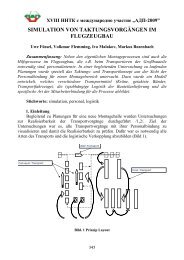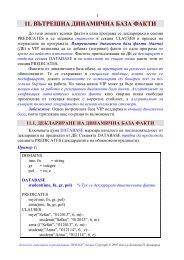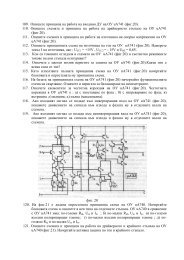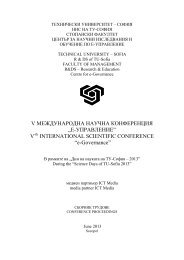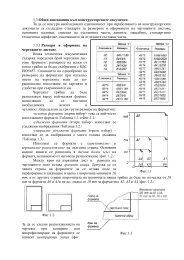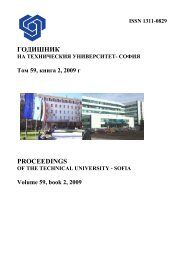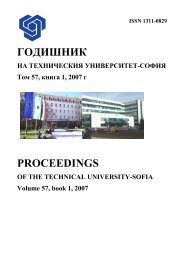Charring rate decreases with increasing density according to the power law –Douglas fir wood belong to the class of high density woods (678 kg/m 3 ), i.e. itscharing rate is about 1 mm/min. Charring rate is not generally much influenced byfire retardants. However, the char yield is usually increased quite a lot, that mightcontribute to the protection of the wood core, [12].DTA Signal, μV6040200346309431421433451455300IP0 200 303 353 400 600 800 1000 12003131234-20Temperature T, 0 C-40-60153158190265159a)Heat Flow q, mJ/min3002502001234515037<strong>61</strong>0034750Exothermic Effects-50-1002770IP0 200 271 400 600 800 1000 1200Endothermic EffectsTemperature T, 0 CFig. 4. Thermal analysis – DTA (a) and DSC (b) curves, of bare Douglas fir wood (1), flame retardedwood by capillary FRIS impregnation with 2 vol. % of anionic surfactant (2) and flame retarded wood byplasma-aided capillary impregnation at different operating rate of DBD pre-treatment: 3 – low frequency(50 Hz) DBD at 10 kV; 4 - low frequency (50 Hz) DBD at 15 kV, and 5 - high frequency (10 kHz) DBD at10 kV (at heating rate of 50 0 C/min).b)90
However, the correlation between results of thermal analysis - TG (DTG), DTA andDSC, and the real fire behavior of wood was not established yet, [13]. Usually thethermal analysis is carried out at thermodynamically stable equilibrium, i.e. thetemperature rate below to the 410 0 C/min range. The real fire reach the flashover(about 600 0 C) for ten minutes and the relevant heating rate is essentially higher –from 50 to 60 0 C/min. One better approximation to real fire might be a thermalanalysis at increased rate of heating (50 0 C/min) closer to the real fire condition.TG and DTG analysis curves of the above described samples are presented in Fig.2a. The mass loss at all studied samples in the first temperature zone (up to the ignitionpoint) is slight due to a release of a small amount of inflammable volatilesubstances and the differences between the samples indicate their different dehydratationand decomposition.The intense pyrolysis of the non-protected wood sample, Fig. 2a, TG-curve 1, inthe flaming zone (the first after the ignition point) is accompanied with a very sharpmass loss (more than 60 %) due to a formation of a lot of low molecular weightflammable volatile products whereas suppressed flaming and started below ignitionpoint (IP) glowing with coal char formation is visually observed for all flame retardedsamples, Fig. 2a, TG-curves 25, accompanied with less mass loss comparedto the control wood sample. The DBD pre-treatment effect on the flame retardencyfor different operational conditions, Fig.2b, DTG-curves 35 was expressed by theappearance of the main peak at lower temperatures (322, 347, 350 0 C) comparing tothe flame retarded wood sample (365 0 C), i.e. it reinforced the flame retardency effect,in comparison with bare wood (411 0 C). The formation of protective barrierchar layer started earlier and finished before the flaming start of the bare wood, Fig.2b. This DBD pre-treatment effect attended with a well expressed growth of theloss of mass compared to the bare wood. The built char barrier (in temperature zoneA) retarded the loss of mass of flame retarded samples after 426430 0 C (zone B),Fig. 3. The total mass loss at the 600 0 C of DBD-aided flame retarded samples was52, 55 % for low and 66 % for high frequency DBD, against 58 % for flame retardedwood samples and 71 % for bare wood.DSC and DTA curves of the flame retarded wood, Fig. 4, curves 25, to that of thebare wood, curve 1, demonstrated significant alterations of the thermal effects andthe head flow in all above described temperature zones indicating in this way thatthe used flame retardant and DBD pre-treatment influenced all steps of the woodpyrolysis and burning.The comparison of curve 2 to curve 1, Fig. 4a, shows: i) a slight shift of the IP tothe higher temperature – from 300 0 C for the bare wood and up to 303350 0 C forthe flame protected one; ii) the appearance of a enlarged endothermic peak at190 0 C for the flame retarded wood evidently is connected to the thermal decompositionof the used flame retardant; iii) the observed for bare wood flaming peak at346 (347) 0 C is suppressed and absorbed by an enlarged charing peak at 433 0 C forflame retarded wood. Such large peak relevant to the building of the protective charbarrier is observed too after the IP at different temperature for DBD pre-treatmentflame retarded wood: 421 and 431 0 C for low and 455 0 C for high frequency DBD.91
- Page 1 and 2:
ISSN 1311-0829ГОДИШНИК НА
- Page 3 and 4:
Годишник на Технич
- Page 5 and 6:
Годишник на Технич
- Page 7:
Годишник на Технич
- Page 10 and 11:
• If a neutral element 1 of the s
- Page 12 and 13:
Proof. (i) Since for arbitrary ≀
- Page 14 and 15:
)is the endomorphism ≀ 0, . . . ,
- Page 16 and 17:
∣∣E (k)C n∣ ∣∣ =Propositi
- Page 18 and 19:
For k = 0 and s = 1 from the last p
- Page 20 and 21:
Facts concerning semilattices can b
- Page 22 and 23:
described by the following join-tab
- Page 24 and 25:
Finally we observe{aj , if i = k(f
- Page 26 and 27:
Let us consider the endomorphisms f
- Page 28 and 29:
Proposition 3.8 For any n ≥ 2 in
- Page 30 and 31:
Cryptographic protocols based on DL
- Page 32 and 33:
2.5 Bi-Semigroup Action Problem (BS
- Page 35 and 36:
Theorem 4.5 [14]. In the center of
- Page 37 and 38:
The only way we know for an attacke
- Page 39 and 40: Годишник на Технич
- Page 41 and 42: The exact definitions of points and
- Page 43 and 44: FirstIterationSecondIterationx 0 0
- Page 45 and 46: * x4. Order of approximationBecause
- Page 47 and 48: Годишник на Технич
- Page 49 and 50: генератори, присъе
- Page 55 and 56: № РежимТабл.4.1 Бала
- Page 57 and 58: Годишник на Технич
- Page 59 and 60: Табл.11 2 3 4 5 6 7Загуби
- Page 61 and 62: оцени разхода на ак
- Page 63 and 64: сформатора се нала
- Page 65 and 66: -да допуска претова
- Page 67 and 68: Годишник на Технич
- Page 69 and 70: -големи трудности п
- Page 71 and 72: трансформаторът се
- Page 73 and 74: При известно фазов
- Page 75 and 76: KU BHOCHR (12)w w wЗа да се
- Page 77 and 78: Годишник на Технич
- Page 79 and 80: aided impregnation of wood and wood
- Page 81 and 82: different as a result of the differ
- Page 83 and 84: Table 2. Carbon peak C s1 component
- Page 85 and 86: Годишник на Технич
- Page 87 and 88: esults indicating that the reductio
- Page 89: Change of Mass M, %100-10-20-30-40
- Page 93 and 94: Electrical Apparatus and Technologi
- Page 95 and 96: Годишник на Технич
- Page 97 and 98: - преходът към стри
- Page 99 and 100: или магнитно изоли
- Page 101 and 102: от лист електротех
- Page 103 and 104: Фиг. 6. Изменение на
- Page 105 and 106: Годишник на Технич
- Page 107 and 108: Fig.1 Block structure of proposed o
- Page 109 and 110: Fig.4. Initial and best shape of po
- Page 111 and 112: Fig.8 Calculated initial cogging to
- Page 113 and 114: Годишник на Технич
- Page 115 and 116: Octave/Lua interface is a Matlab to
- Page 117 and 118: pends on the results of the thermal
- Page 119 and 120: 4. ResultsAs it has been mentioned
- Page 121 and 122: A DC electromagnetic actuators with
- Page 123 and 124: Годишник на Технич
- Page 125 and 126: ращ се наблизо пров
- Page 127 and 128: Фиг. 4. Зависимост н
- Page 129 and 130: че максималната то
- Page 131 and 132: 3.7. Ефект близост в
- Page 133 and 134: Годишник на Технич
- Page 135 and 136: 11 c x6T 2 c3c4c5ec p c1c , (2)
- Page 137 and 138: От кривата на макси
- Page 139 and 140: 109.598.5Wind speed, m/s87.576.565.
- Page 141 and 142:
6. ЗаключениеВ стат
- Page 143 and 144:
Годишник на Технич
- Page 145 and 146:
Фиг.1. Заместваща сх
- Page 147 and 148:
където t е времето м
- Page 149 and 150:
Бяха проведени и ек
- Page 151 and 152:
Представени са рез
- Page 153 and 154:
Годишник на Технич
- Page 155 and 156:
Фиг.3. Архитектури н
- Page 157 and 158:
P SC_refP batP WP HGP storP bat_ref
- Page 159 and 160:
1500Фиг.9. Модел в Matlab/
- Page 161 and 162:
Isc, AVsc, V50403020100-10-20-30-40
- Page 163 and 164:
Годишник на Технич
- Page 165 and 166:
шаване на температ
- Page 167 and 168:
При променлив темп
- Page 169 and 170:
Годишник на Технич
- Page 171 and 172:
2. Примерни компютъ
- Page 173 and 174:
3.3. Изследване на фо
- Page 175 and 176:
алгебра. За целта с
- Page 177 and 178:
3.13. Изчисляване на
- Page 179 and 180:
Годишник на Технич
- Page 181 and 182:
Количеството на от
- Page 183 and 184:
(CaSO 4 .2H 2 O) (фиг. 3). То
- Page 185 and 186:
работят всички инс
- Page 187 and 188:
(НДНТ), което за Бъл
- Page 189 and 190:
Годишник на Технич
- Page 191 and 192:
Communications software and hardwar
- Page 193 and 194:
puter is running virtualization sof
- Page 195 and 196:
execution to the dispatcher applica
- Page 197 and 198:
Годишник на Технич
- Page 199 and 200:
Тунелирането скрив
- Page 201 and 202:
управление на ресу
- Page 203 and 204:
Фиг.6: Симулационен
- Page 205 and 206:
tunnel source 1.1.1.1tunnel destina
- Page 207 and 208:
Годишник на Технич
- Page 209 and 210:
При отворена вериг
- Page 211 and 212:
Таблица 3Задвижващ
- Page 213 and 214:
Фигура 3.При съотно
- Page 215 and 216:
Годишник на Технич
- Page 217 and 218:
Необходимо е така д
- Page 219 and 220:
yследователно:( k )UOsi
- Page 221 and 222:
Годишник на Технич
- Page 223 and 224:
Laskin and Wang presented a detaile
- Page 225 and 226:
Figure 2: Temperature dependence of
- Page 227 and 228:
An additional analysis obtained at



